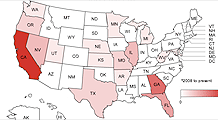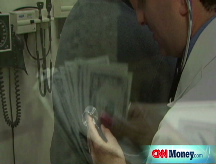Problem bank list tops 250
FDIC reports that number of troubled institutions soared during the fourth quarter to the highest level since 1994.
NEW YORK (CNNMoney.com) -- The government's closely watched list of troubled banks grew during the fourth quarter to its highest level since 1994, regulators said Thursday.
The Federal Deposit Insurance Corp. reported that the number of firms on its so-called "problem bank" list grew to 252 during the last three months of 2008, compared with 171 banks making the list in the prior quarter.
"There is no question that this is one of the most difficult periods we have encountered during the FDIC's 75 years of operation," agency Chairman Sheila Bair said Thursday.
Problem banks typically face difficulties with their finances, or are suffering through operations or management issues that pose a threat to their existence.
The institutions that wind up on the list are considered the most likely to fail, although few of them actually reach that point. On average, just 13% of banks on the FDIC's problem list have failed.
The FDIC - one of the top regulators of the nation's banking system - doesn't reveal the names of the banks on the list, but it does give the total assets of these institutions.
That number topped $159 billion during the most recent quarter, up from $116 billion the previous quarter.
As the U.S. economy has deteriorated, the pace of bank failures has quickened in recent months as banks struggle under the weight of rising loan losses.
Fourteen banks have failed so far this year, including last week's collapse of Silver Falls Bank, a relatively tiny Oregon-based institution located about an hour south of Portland.
Still, the current crop of bank failures hardly comes close to what happened during the savings & loan crisis two decades ago. More than 1,900 financial institutions went under during 1987-1991, peaking with the failure of 534 banks in 1989.
In the event of a failure, the FDIC fully insures individual accounts up to $250,000 for single accounts.
Overall, the fourth quarter proved to be an incredibly difficult period for the more than 8,300 banks that make up the nation's banking industry.
During the period, the group posted a net loss of $26.2 billion, representing its largest quarterly hit in the 25 years that insured institutions have reported quarterly results.
Regulators blamed a combination of factors for the quarter including losses from trading activity, massive writedowns taken by banks as well as rising loan losses.
To cope with the deteriorating economic environment, banks set aside a whopping $69.3 billion in funds for future loan losses - more than double year-ago levels.
"The trend is clear - troubled loans are rising and will continue to rise in the near future," said Bair.
The latest assessment of the health of the nation's banking sector comes just a day after industry regulators unveiled plans to "stress test" the nation's 19 largest banks in order to gauge the size and scope of any future government aid.
Sor far, the Treasury Department has extended nearly $200 billion in aid to banks, with the bulk of that aid going to some of the nation's biggest lenders including Citigroup (C, Fortune 500), Bank of America (BAC, Fortune 500) as well as Wells Fargo (WFC, Fortune 500) and JPMorgan Chase (JPM, Fortune 500).
FDIC's Bair threw her support behind the open-bank assistance efforts taken so far, noting that her agency would face limitations if it attempted to place a leading bank into receivership.
Such actions would not only fall somewhat outside the agency's authority, but she also noted that the FDIC could face a "resource issue" if it attempted to undertake such a task. ![]()



